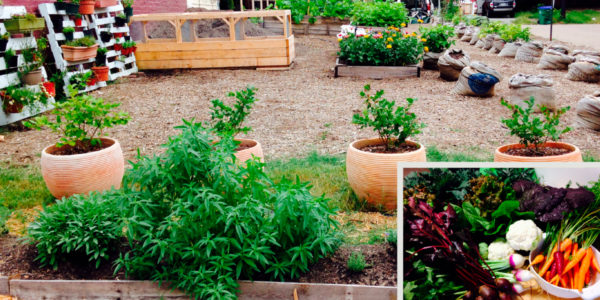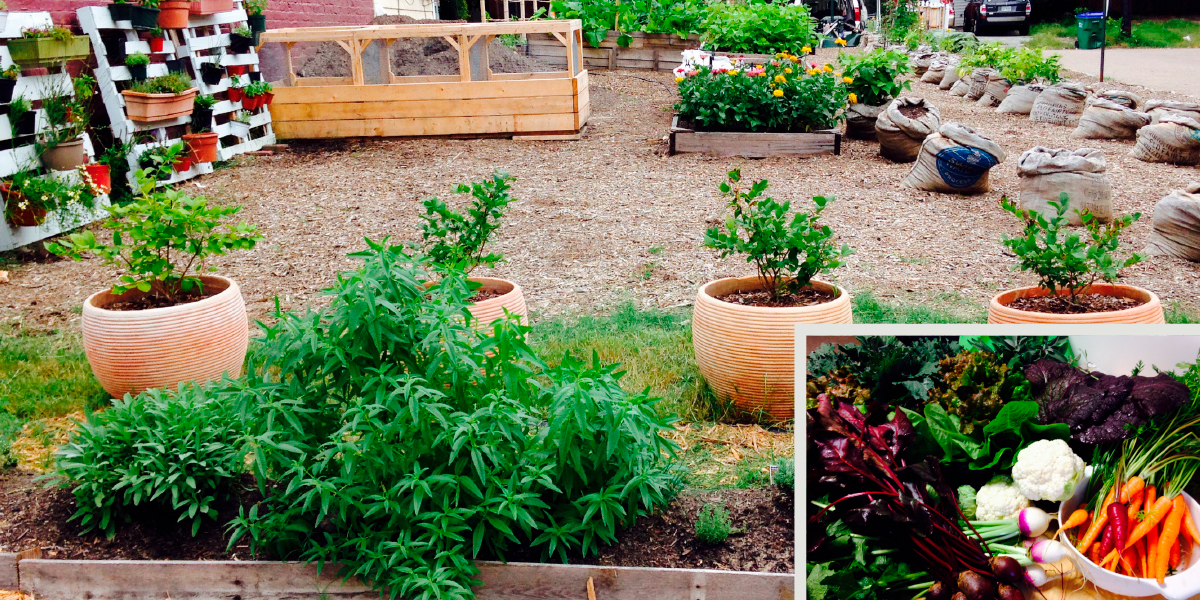Leaders at the Office of Sustainability at Virginia Commonwealth University (VCU) had very different plans for the town house–sized lot—originally destined to be a parking deck—gifted to them by Parking and Transportation in 2015. In response to an apparent need—both on and off campus—we transformed that space into a Learning Garden: a high-production vegetable garden that provides fresh food and educational opportunities to our students and others living in Richmond, Va. Numerous factors, including proximity to a grocery store, transportation, education/information, and financial strain, can affect food access. According to a 2014 study conducted by the Virginia Food Desert Task Force, about 23 percent of Richmond’s population is food insecure (lacking reliable access to affordable, nutritious food), and one-fifth (20 percent) of the city’s residents live in food deserts with limited access to groceries. These two factors greatly impede the ability to maintain a healthy diet and lead a healthy life. After conducting a survey on campus in 2013, we found that many VCU students struggle with food insecurity as well. By combining emergency food assistance with hands-on learning, the university could help alleviate food insecurity both on its campus and in the urban community with which it is intertwined. When we floated the idea of an on-campus Learning Garden, the response from students was overwhelmingly positive. Our goals were to:
- Provide students and community members with hands-on, educational opportunities related to gardening, food access, and food systems.
- Create a universally accessible and inclusive garden space.
- Alleviate food insecurity at VCU and in the surrounding area by regularly donating produce to university and community organizations that serve populations in need.
- Create a national model and resource to guide other university and city organizations in creating their own learning gardens.
In the summer of 2015, VCU’s Division of Community Engagement awarded seed money to the Office of Sustainability through an internal grant. We immediately started looking for a location near VCU’s urban campus and a learning garden coordinator who would maintain our garden, coordinate volunteers, and collaborate with community partners. The vacant lot owned by Parking and Transportation came with a few challenges—including heavy, clay soil and shade from adjacent buildings—but also enormous potential. Using the $6,000 grant, along with funds from our office operating budget, we graded the site so that the slope of the garden would meet Americans With Disabilities Act standards. We then installed irrigation, removed an invasive tree, and created a handicapped-accessible parking space at the rear of the garden. The winter of 2016 was spent spreading mulch, hauling dirt, and building raised beds and vertical growing spaces—using entirely reclaimed materials. Our creative reuse of pallets, warped studs, and burlap bags not only cut our costs significantly, but also provides the community with examples of sustainable, low-cost garden ideas for urban spaces.

From Garden to Table
Since the start of our first growing season in April 2016, the Learning Garden has yielded nearly 500 pounds of fresh produce for donation. Those fresh-from-the-garden products range from tomatoes and salad greens to cucumbers and cauliflower. Two partner organizations, one internal and one external, distribute the produce to individuals experiencing food insecurity. On campus, for example, produce from the Learning Garden can be found at RamPantry, a food pantry that provides emergency food to VCU students in need. Vegetables—typically harvested just before the pantry opens at 11 a.m.—are labeled with nutritional information and preparation ideas. Students who use the pantry are limited to five staple items, but they may take as much fresh produce as they’d like. It’s not unusual for the fresh produce to be claimed even before it gets on the shelf. The garden, which was designed to utilize sustainable methods for high-output crop production, depends heavily on the support of volunteers. The nearly 90 volunteers who worked in the garden last year included many pantry users, who appreciate learning where their food comes from and how it’s grown. Our external partner, the Center for Healthy Hearts, is just a few blocks from the garden itself. The center is a free health clinic that serves low-income and underinsured Richmonders dealing with health issues such as high blood pressure, diabetes, and hypertension. Health-care professionals at the center use the produce for cooking demonstrations and nutrition workshops, often prescribing the fresh produce to patients whose issues are explicitly linked to diet. After just one growing season, we’ve been able to work with multiple classes, conduct workshops, and give many presentations on creating a healthier food system and improving equitable access to healthy food. The sustainability office’s operating budget pays for mulch, compost, fertilizer, seeds, tools, and general equipment maintenance related to the garden, plus materials distributed at events and workshops. In the future, we’d like to build an outdoor classroom to facilitate deeper learning opportunities and hope to double production (and food donations) with the addition of tabletop beds and other creative growing spaces. We plan to expand a native flower bed within the 1,200-square-foot garden to encourage healthy pollinator populations and serve as an educational tool. Also in the works are internship and course credit opportunities, something we believe will engage VCU students in the work of food justice on a new level.
Widespread Initiatives
In addition to its Learning Garden, VCU maintains an on-campus community garden close to its student center. Initiated in 2012 by Green Unity, a student group, this 1,300-square-foot growing space features 14 raised beds as well as two ADA-accessible beds for standing/wheelchair use, divided into small plots. Any VCU student, staff, or faculty member—or a group of them—can rent a plot for a semester or the entire year for growing food and flowers for personal use. Increasing student and community engagement with both gardens is one of the 17 goals articulated in VCU’s sustainability plan. The plan was developed in 2015 with input from VCU stakeholders at two town hall events and from community members involved in five neighborhood associations. Here’s some of the progress VCU has made on its other sustainability goals:
- On the academic front, VCU now offers 82 courses that incorporate sustainability in some way.
- Since 2013, VCU has recycled approximately 2,000 pounds of textile scraps from its Fashion Design department.
- For its dining services, VCU purchases all dairy products and tofu from at least eight local farms.
- More than one quarter (27 percent) of all university waste is diverted and recycled as part of VCU’s single-stream collection program.
- On the VCU campus, 33 of the most active buildings have at least one “filling station” for water bottles, keeping an estimated 1 million plastic water bottles out of landfills each year.
The university’s sustainability committee provides guidance and feedback related to the overall sustainability plan. Co-chaired by the provost and the vice president for finance and administration, the committee meets at least once per semester and includes representatives from the faculty, staff, and student body.
SUBMITTED BY Erin Stanforth, director of sustainability, and Hannah Wittwer, Learning Garden coordinator, Virginia Commonwealth University, Richmond, Va.



